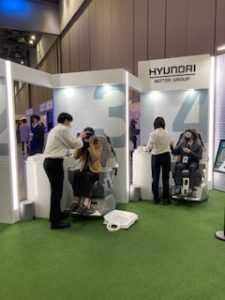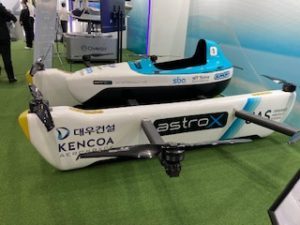 Two years ago, in November of 2020, the Mayor of Seoul took a ride in an EHang 216. The autonomous test flight was launched over the densely populated city of Seoul, under a “Special Certificate of Airworthiness,” the first ever granted in Korea to a passenger-grade AAV.
Two years ago, in November of 2020, the Mayor of Seoul took a ride in an EHang 216. The autonomous test flight was launched over the densely populated city of Seoul, under a “Special Certificate of Airworthiness,” the first ever granted in Korea to a passenger-grade AAV.

The flight marked the first trial flight after the Korea government announced the “Korean Urban Air Mobility (K-UAM) Roadmap” in June 2020, projecting that commercial passenger drone services would be available as soon as 2023. One year later, in November of 2021, Volocopter launched their first crewed test flight in Seoul, with Volocopter CEO Florian Reuter stating: “With MOLIT’s comprehensive K-UAM roadmap, South Korea is well positioned to achieve the goal of commercializing UAM by 2025.”
It’s a short time frame. But as the impressive display of scale models, full-size aircraft, flight simulators, and more on display at this week’s Smart Geo Expo in Goyang demonstrates, the Korean government, industry, and people are ready to take off.

People crowded in to the UAM hall to experience flight simulations of what an air taxi feels like. In a mix of amusement park ride experience and highly sophisticated engineering, participants donned VR headsets and took their seats to experience UAM flight – in some cases as a passenger, in others as a pilot. It was an amazing experience – not quite like riding in an airplane, not exactly like riding in an elevator: but certainly secure, and as a first time passenger, exciting.

Perhaps most interesting about the S. Korean UAM sector is the wide variety of industry participants. In addition to Ehang and Hyundai’s Supernal were models of the Hanwha Systems Butterfly, jointly developed with US-based OverAir. The tilt-rotor eVTOL is designed to minimize noise. Kencoa Aerospace’s AstroX’s open cockpit design with pontoons was totally unlike other models on display: it’s designed to be flown from a boat to the airport. Research institutions and government agencies participated in developing the simulators on display.

Scale models of vertiports – and vertistops, like a subway station or bus stop – under design were also on display, to give people an idea of what the UAM infrastructure will look like.

From the line of young people, business people, and spectators waiting to experience UAM flight in a simulation environment, air taxis will be met with enthusiasm when the do launch commercially.
Read more about urban air mobility in Korea:
- Urban Air Mobility in Korea: Volocopter Conducts First Crewed Public Air Taxi Flight
- Passenger Drones in Korea: EHang 216s Flight Tour Takes Off [VIDEO]
- Ehang Passenger Drone Makes Debut Flight in Korea: Air Taxis a Dream of Mankind [VIDEO]
- Urban Air Mobility Could Generate Billions for Cities Around the World: Volocopter in Singapore

Miriam McNabb is the Editor-in-Chief of DRONELIFE and CEO of JobForDrones, a professional drone services marketplace, and a fascinated observer of the emerging drone industry and the regulatory environment for drones. Miriam has penned over 3,000 articles focused on the commercial drone space and is an international speaker and recognized figure in the industry. Miriam has a degree from the University of Chicago and over 20 years of experience in high tech sales and marketing for new technologies.
For drone industry consulting or writing, Email Miriam.
TWITTER:@spaldingbarker
Subscribe to DroneLife here.







[…] More… […]